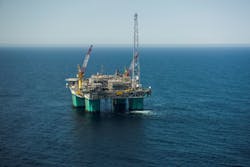Offshore staff
LONDON – Neptune Energy has issued a detailed update of its E&P plans for its North Sea area interests, although these may be subject to current and future developments.
In the Norwegian Sea, the Wintershall Dea-operated Dvalin development is due onstream in 4Q 2020, while the Nova field, a tieback to Neptune’s operated Gjøa field, set to start production in 2021. Together these will add around 12,000 boe/d of net production at plateau.
This year, the company’s production in Norway is set to be lower due to natural declines and extended shutdowns planned at Gjøa for required work associated with the Gjøa P1, Duva and Nova tie-ins.
Declines will be partly offset by additional volumes from Fram in the North Sea, following start-up of the Troll C gas module, and new infill wells at Gudrun, Draugen, and Vega.
During 4Q the Askaladd gas-condensate field in the Barents Sea should come onstream, increasing available production capacity at Snøhvit.
At Neptune’s operated Fenja development in the Norwegian Sea, processing modules have been installed on the host Njord A platform and the first subsea umbilicals, risers and flowlines has finished.
Development drilling was due to start early this year and a second subsea installation campaign is planned this summer ahead of start-up in 1Q 2021.
Sail-away of the refurbished Njord A platform and Njord B FSO for the Njord redevelopment should occur during 3Q.
For Duva and Gjøa P1, this year’s planned subsea campaign comprises pipelay, subsea installations and umbilical pull-in, with all operations set to be completed by 4Q. The present six-well development program will continue throughout 2020, with subsea installations sequenced around the drilling campaigns to optimize delivery.
For Nova, the processing module should be placed on the Gjøa semisubmersible platform shortly with six wells to be drilled.
In the Dutch North Sea, Neptune entered 2020 with plans for five new development wells, including the delayed L5a-D4 well.
Its program includes two wells as part of Wintershall Dea’s Sillimanite development and two operated infill wells (K9ab-A4 and L15-A109) in the western Dutch North Sea, both scheduled for the latter part of the year.
The Sillimanite South exploration well, due to be drilled this summer, offers further gas production upside if successful and could be tied-in before year-end.
Last July, Neptune was chosen to participate in a pilot project to create the first offshore hydrogen plant in the Dutch sector. PosHYdon, which will be installed on the company’s Q13a-A platform, is a collaboration with Nexstep and TNO and will generate hydrogen using an electrolyser powered by wind energy.
Hydrogen will be blended into the existing pipeline infrastructure and used to generate electricity. Preparations for the FEED process should start in the coming months, with first hydrogen production anticipated in 2021.
This year, the company expects to complete decommissioning activity at the offshore L10 C, D and G platforms. The D18-A platform is due to cease production during the year and preparations for future decommissioning will commence.
In the UK central North Sea, Neptune expects construction to start this year of the topside module to receive production from the Seagull field, where operations are due to begin in the second half of 2021.
Preparations continue at Cygnus in the southern UK gas basin for a tenth infill well.
Last year the company participated in the drilling of the Darach well and subsequent side track, which confirmed the presence of oil and gas. Appraisal studies are planned to determine volumes and assess the discovery’s commercial potential: Spirit Energy has been named operator of the license.
Planning is under way for an appraisal well on Glengorm South in the central sector.
Offshore Indonesia, the pipeline for Eni’s deepwater Merakes project (a five subsea-well tieback to the Jangkrik FPU) was installed in early 2020 and fabrication of the major FPU and SURF modules is advanced.
However, Eni has declared force majeure due to the impact of COVID-19, so first gas has now been pushed back to mid-2021.
03/31/2020



